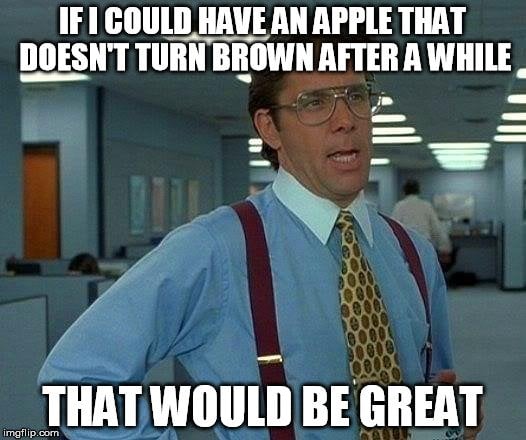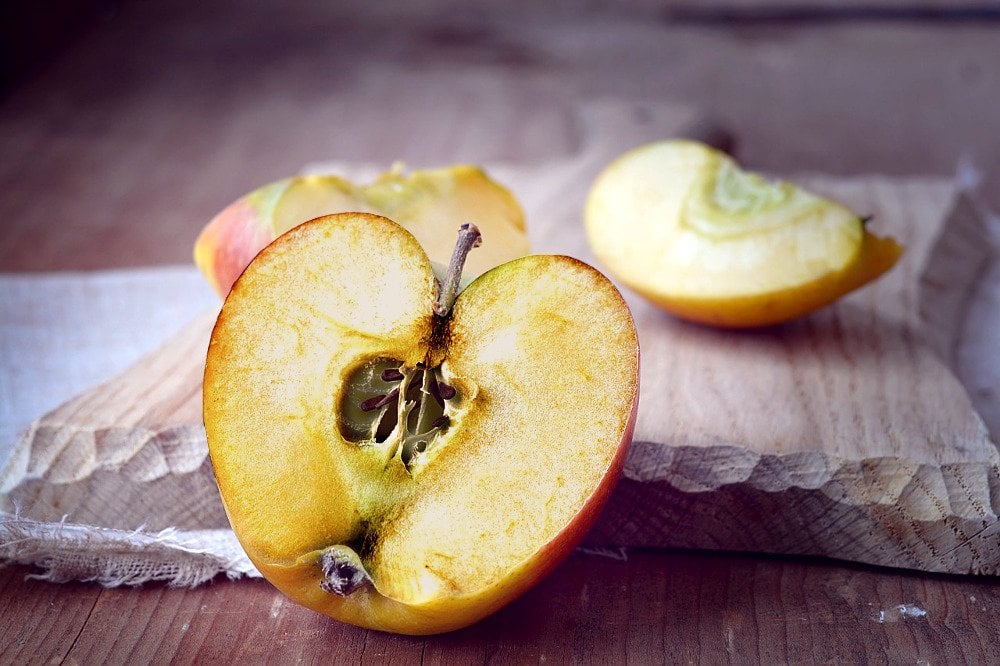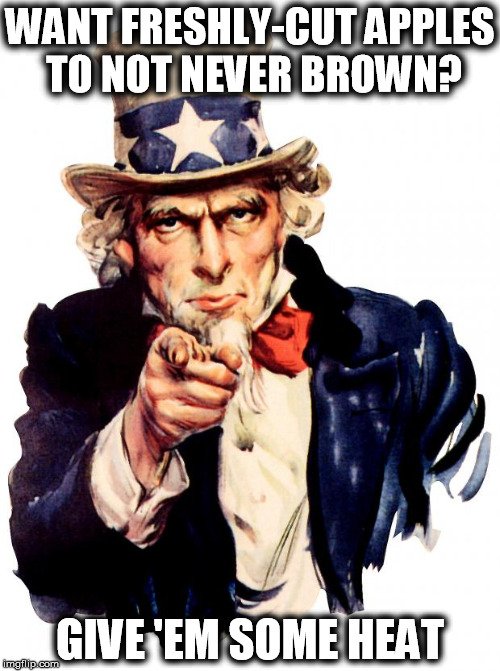What Causes the Browning of Apples Slices Easy Explanation
Why Do Apples Turn Brown? How To Keep Apples From Turning Brown?
Updated on: 22 Jan 2022 by Ashish
A freshly cut apple eventually turns brown after being exposed to air because its cells contain an enzyme called polyphenol oxidase. When this comes in contact with oxygen present in the environment, it turns the phenolic compounds present in the apple tissues into brown-colored products, imparting a brownish tinge to the freshly cut apple.
I have always been fond of apples. They're sweet, juicy, crispy and most importantly, they keep doctors away!
But they do have a major drawback – freshly cut apples, if left in the open, eventually turn brown. Well, technically, it's not their drawback, but it's certainly something that makes it a less ideal fruit for people who eat slow!

The question is, why do freshly cut apples turn brown? And perhaps more importantly, what can be done to keep apples from taking on that brownish hue?
Recommended Video for you:
The 'browning' of an apple
Take a bite, or as many as you want, from a fresh, bright red apple, but make sure you finish off the apple soon after, i.e., never make the mistake of taking a bite or two and then leaving it in the open for an hour, unless you want to eat a flaccid brownish mess that was once your apple.
It seems that apples have a self-destruct switch inside them that gets activated the moment you cut it with a knife or take that first bite. It gradually starts to turn brown and mushy. To a 3-year-old who believes that Hogwarts is real (for the record, many adults also believe this), it might seem like some sort of sorcery, but in reality, it's just science. In fact, this is a classic example of what adults like to call an 'oxidation reaction'.

Not so appetizing, is it? (Photo Credit : Pixabay)
Oxidation of a freshly cut apple
We all know that organic matter is made of millions upon billions of tiny cells of varying kinds. These cells also contain different types of enzymes. One of those enzymes that is present in the flesh of both apples and humans is called Polyphenol Oxidase (commonly abbreviated as PPO).
When an apple is cut, the oxygen present in the surroundings comes in contact with the 'injured' plant tissue. When this happens, the PPO enzymes (present in the chloroplasts) react with the phenolic compounds (which are naturally present in the apple tissues). In more chemical terms, you'd say that PPO enzymes 'oxidize' the phenolic compounds, which is why this reaction is classified as an oxidation reaction.
As a result of this oxidation reaction, colorless o-quinones are formed, which, after a few subsequent chemical reactions (with proteins or amino acids), lead to the browning of any freshly cut apple.

Now that you know what goes on in the background when an apple turns brown, let's look at a few ways that can prevent this breakdown from happening.
How can you keep apples from turning brown?
There are two approaches to dealing with the 'browning apple' problem: you can either take out the oxygen from the equation or hinder the functioning of the PPO enzymes.
Taking oxygen out of the system is easy; you just have to cut off the oxygen supply to the half-eaten apple. This can be done in multiple ways – you can coat the apple with sugary syrup, lemon juice or any other citrus fruit juice. This will put a physical barrier between the exposed cells in the flesh and the surrounding oxygen, which will decrease the diffusion of oxygen through the apple's cells.

Some people simply toss their freshly-cut apples in a bowl of water to cut off their supply of oxygen. It certainly works, but only if you plan to keep them submerged in water for a short time.
In fact, coating an apple with lemon juice not only affects its oxygen supply, but also impacts the function of enzymes. Lemon juice brings down the pH of the environment of the apple, thereby attacking the efficiency of PPO.
A surefire way to stop apples from turning brown is to apply heat to them, either by cooking or briefly blanching them in water.

Heat causes a permanent alteration of the structure of these enzymes (which are basically proteins) due to a process called denaturation (you may have have heard of this term in relation to boiled eggs). Once denatured, these enzymes are no longer capable of turning the apple brown. Therefore, the apple may go bad/spoil due to some other natural process, but it certainly won't turn that unpleasant shade of brown.
Suggested Reading
-
The Atom: A Visual Tour (The MIT Press) -
The Alchemy of Air: A Jewish Genius, a Doomed Tycoon, and the Scientific Discovery That Fed the World but Fueled the Rise of Hitler -
Salt: A World History
Was this article helpful?
Yes No
Help us make this article better
Follow ScienceABC on Social Media:
About the Author
Ashish is a Science graduate (Bachelor of Science) from Punjabi University (India). He spearheads the content and editorial wing of ScienceABC and manages its official Youtube channel. He's a Harry Potter fan and tries, in vain, to use spells and charms (Accio! [insert object name]) in real life to get things done. He totally gets why JRR Tolkien would create, from scratch, a language spoken by elves, and tries to bring the same passion in everything he does. A big admirer of Richard Feynman and Nikola Tesla, he obsesses over how thoroughly science dictates every aspect of life… in this universe, at least.
.
Science ABC YouTube Videos
-
 Why is a Circle 360 Degrees, Why Not a Simpler Number, like 100?
Why is a Circle 360 Degrees, Why Not a Simpler Number, like 100? -
 Quantum Physics: Here's Why Movies Always Get It Wrong
Quantum Physics: Here's Why Movies Always Get It Wrong -
 Do Fish Get Thirsty and Do They Need to Drink Water?
Do Fish Get Thirsty and Do They Need to Drink Water? -
 Gasoline (Petrol) vs Diesel: Which one is better? A Beginner's Guide
Gasoline (Petrol) vs Diesel: Which one is better? A Beginner's Guide -
 Black Holes Explained: What Is a Black Hole? How They Form?
Black Holes Explained: What Is a Black Hole? How They Form? -
 Gut Microbiome Explained in Simple Words
Gut Microbiome Explained in Simple Words -
 Particle accelerators: What are they, how do they work and why are they important to us?
Particle accelerators: What are they, how do they work and why are they important to us? -
 How Do Neurons Work?
How Do Neurons Work?
Source: https://www.scienceabc.com/eyeopeners/why-do-apples-turn-brown-and-how-can-you-prevent-it.html



Post a Comment for "What Causes the Browning of Apples Slices Easy Explanation"